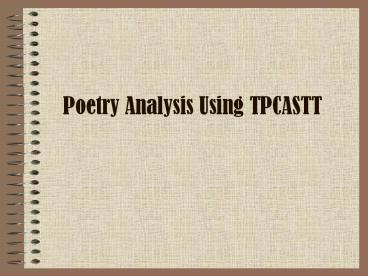Poetry Analysis Using TPCASTT - PowerPoint PPT Presentation
1 / 13
Title:
Poetry Analysis Using TPCASTT
Description:
This may be three sentences or a page, depending on the particular poem. C is for CONNOTATION Analyze the figures of speech and sound effects of the poem. – PowerPoint PPT presentation
Number of Views:217
Avg rating:3.0/5.0
Title: Poetry Analysis Using TPCASTT
1
Poetry Analysis Using TPCASTT
2
Getting Started
- This is a process to help you organize your
analysis of poetry. - Together, we are going to analyze Strange Fruit
using TPCASTT. - You have a note sheet that looks like this
3
Add your analysis of Strange Fruit to this
sheet!
4
T is for TITLE
- Analyze the title first.
- What do you predict this poem will be about?
- Write down your predictions.
- We will reflect on the title again after we have
read the poem. - The next step is often omitted, but it is the
most important!!!!
5
READ THE POEM!!!!
6
Strange Fruitby Abel Meeropol a.k.a. Lewis
Allen
Southern trees bear a strange fruit,Blood
on the leaves and blood at the root,Black body
swinging in the Southern breeze,Strange fruit
hanging from the poplar trees.Pastoral scene of
the gallant South,The bulging eyes and the
twisted mouth,Scent of magnolia sweet and
fresh,And the sudden smell of burning
flesh!Here is a fruit for the crows to
pluck,For the rain to gather, for the wind to
suck,For the sun to rot, for a tree to
drop,Here is a strange and bitter crop.
7
P is for PARAPHRASE
- Paraphrasing is putting something in your own
words. - After reading the poem, rewrite it in your own
words. - This may be three sentences or a page, depending
on the particular poem.
8
C is for CONNOTATION
apostrophe
- Analyze the figures of speech and sound effects
of the poem. - These are the poetry vocabulary we have already
studied. - These elements add to the meaning.
ASSONANCE
alliteration
RHYME
diction
personification
simile
onomatopoeia
implied metaphor
meter
HYPERBOLE
direct metaphor
9
A is for ATTITUDE
- Tone is the attitude of the speaker toward the
subject of the poem.
10
S is for SHIFT
- If there is a change in
- Time
- Tone
- Speaker
- This should always be noted as this will also
affect the meaning.
11
T is for TITLE (again)
- At this time, you should reconsider the title.
- Were you right in your predictions?
- What other meanings might the title have in light
of your analysis? - Next, the biggie.
12
T is for THEME
- As you already know, theme is the general insight
into life conveyed by the author through his/her
work. - It does not make a judgment.
- example Dont do drugs is not a theme.
- It merely states something that is true to life
and the human condition.
13
How do I find the THEME?
- Look at the other parts of TPCASTT.
- What insight are all of these working together to
convey? - What is the poet trying to say about life?































